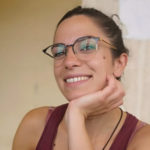joined the THREAD project in May 2020 (read her welcome message)
My name is Martina Stavole and I am an Italian Civil engineer graduated at University of Cassino and Southern Lazio. My passion for math and structural design brought me to study Civil engineering.
I broadened my experience in this field thanks to my semester at Budapest- BME where I worked on numerical methods, in the computational field and steel structures. Attending the New York International Summer School at Fordham University I became much more interested to seismic response and structural strengthening of historic buildings. Thanks to this experience, I decided to focus my research on seismic response studies, a topic which I covered as a researcher at University of Minho. There, I specifically analysed the dynamic response of compressed earth blocks (CEB). I deepened my knowledge of implementation and calibration of contact interfaces within several materials in detailed micro-modelling problems to study the local nonlinear behaviour of strengthening systems as a fellow researcher at University of Cassino and Southern Lazio, enjoying also the teaching and the tutoring activities.
The main driver behind my application to THREAD is the passion and the will to continue my career in an international and dynamic environment where I could address these topics with colleagues coming from different backgrounds. This experience represents a crucial chance for me to actively contribute to innovative projects with an effective impact on our everyday life.
Martina Stavole, May 2020

